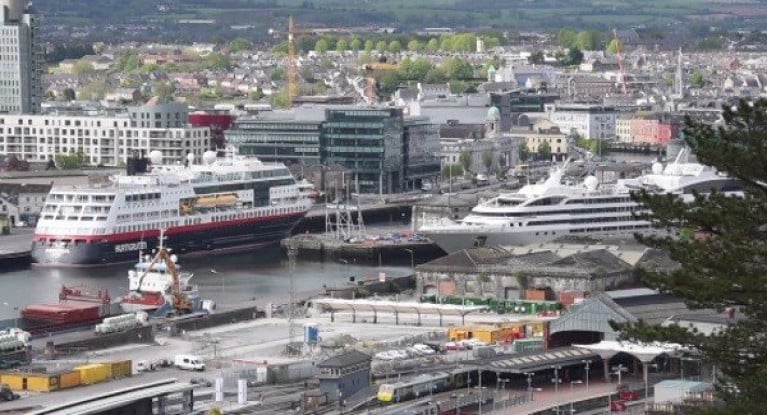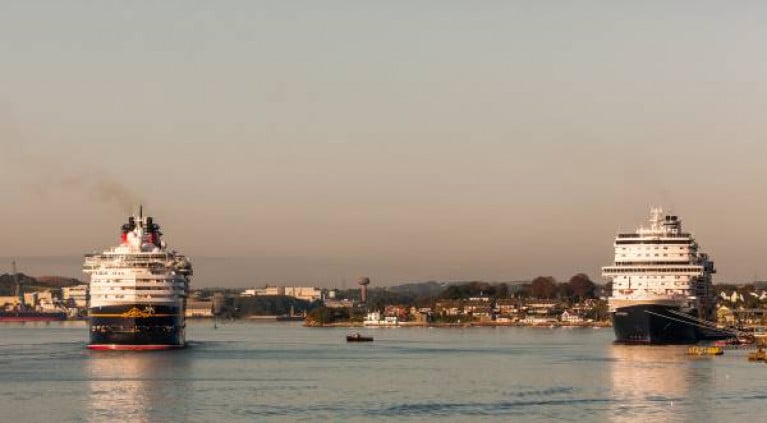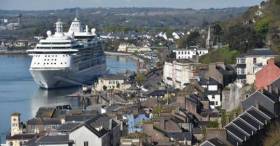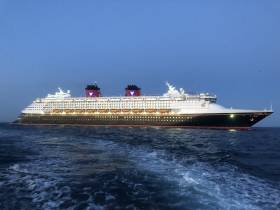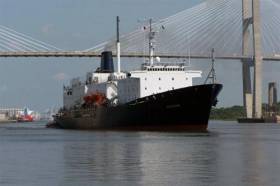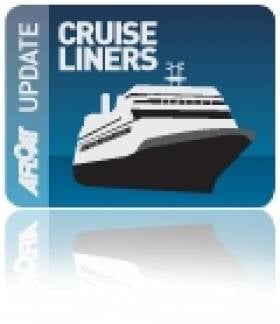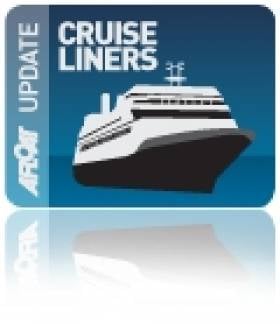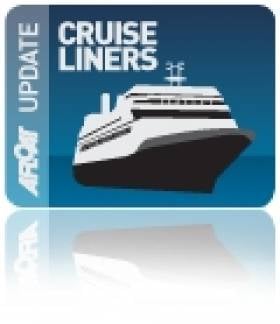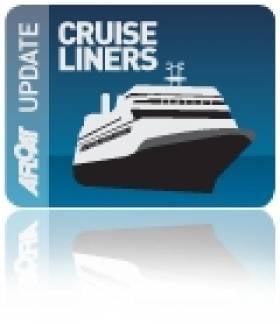Displaying items by tag: Cobh Cruise Terminal
Cruise Ships Sail Ahead into Cork Harbour Despite Covid-19 Fears
Cork Harbour's lucrative cruise season will continue as planned, despite coronavirus fears, writes the Irish Examiner.
The Port of Cork said steps have been taken ahead of the arrival of the first cruise liner of the 2020 season.
The Saga Sapphire is due in Cobh on Friday morning with up to 752 passengers and a further 400 crew. It will arrive at the end of a coastal cruise of Ireland and the UK, having already docked in Liverpool and Dublin (yesterday to overnight in port Afloat adds) before setting off back to Dover.
There is just one other cruise liner due this month: the Marco Polo (also Cobh, Afloat confirms), which is scheduled to arrive on March 23. From April onwards, though, the numbers arriving will increase rapidly.
Currently, there are plans for a record 107 cruise liners to visit Cork (majority to Cobh) in the coming months. Passenger numbers were projected to reach 260,000.
For more on the coronavirus struck cruise ship Grand Princess in the US, as Afloat previously reported and a comment from the Port of Cork click here.
As Coronavirus Spreads Fears for Cruise Travel to Cork Harbour
Cork Harbour could fall victim to a drop in cruise travel as a result of the novel coronavirus outbreak.
As EchoLive.ie reports, the Centres for Disease Control and Prevention (CDC) has issued an update to anyone with imminent cruises booked, advising all travellers, particularly those with underlying health issues, to defer all cruise ship travel worldwide.
The advice follows the news that cruise ship, the Grand Princess, was held 30 miles off the coast of San Francisco for several days after 21 people tested positive for Covid-19. Passengers on the Grand Princess are set to be evacuated in Oakland, California (plus RTE News) over the next two to three days and will be quarried for a 14 day period.
The CDC has concluded that cruise ships pose a significant threat in spreading the virus. “Recent reports of Covid-19 on cruise ships highlight the risk of infection to cruise ship passengers and crew. Like many other viruses, Covid-19 appears to spread more easily between people in close quarters aboard ships,” the organisation said.
More on the story here which added there could be an impact on the Port of Cork which welcomed a record 100 cruise ships into Cork Harbour last year.
Afloat adds the majority of cruise calls take place at Cobh where a French Navy frigate recently docked alongside the cruise-orientated pontoon. In addition cruise ship's dock at Ringaskiddy (Deepwater Berth) whereas smaller ships navigate upriver to Cork city centre to berth at the South Quays..
When cruiseships dock in Cobh they have been warned to keep quiet by the Port of Cork.
The busy port, writes Echolive, which sees up to 100 cruise liners docking throughout the year in the tourist town, has issued a statement regarding noise levels at certain times in an effort to maintain a good relationship with local residents.
In a notice, issued by Captain Paul O’Regan, who is Harbour Master and Chief Operations Officer for the Port of Cork, cruise liner captains were asked to reduce noise pollution in the area.
The notice from Captain O’Regan said that due to the topography of Cobh Cruise Berth, the sound from passenger announcements, music played on external decks and alarm sirens were amplified and this can be an issue for the surrounding residential properties.
To find out the times ship masters must adhere to when using alarms and announcements click here.
Disney Magic Makes Maiden Call to Port of Cork
#CruiseLiners - Disney Magic made a maiden call to the Port of Cork this morning.
The Port of Cork welcomed the Disney Magic on the maiden call to Cobh, as part of Disney Cruise Line’s new seven-night British Isles cruise. Capable of holding 2,713 guests and 950 crew, the Disney Magic is designed primarily with the family in mind.
To mark the Disney Magic’s maiden call and to ensure a warm welcome for the passengers to Cobh, a number of free family focused events will take place from 2.30pm on the promenade in Cobh. These include an outdoor ball pool trailer, balloon modelling, face painting, a ‘Tony Balone’ magic show and family friendly music on the bandstand. The Cobh Confraternity Band will play on the bandstand as the liner departs and Disney Cruise Line has confirmed as a special bonus; the Disney characters will be out on deck to wave goodbye as the liner passes the promenade in Cobh.
Chief Executive Brendan Keating said: ‘Welcoming the Disney Magic to Cork is a real honour for the Port of Cork and we look forward to further calls from this admired cruise line.’
Disney Cruise Line described Cork as ‘home to a vibrant culinary scene and a plethora of pubs, shops and cafes. It invites visitors to connect with Ireland’s ancient past, with historic sites like Blarney Castle, where visitors can kiss the famed Blarney Stone.’
Following a request by Disney Cruise Line the Deep-water Quay in Cobh will be closed to the public from 2pm until the Disney Magic departs at 6.15pm. The Port of Cork is encouraging anyone coming to Cobh to see the ship to view it from the High Road or promenade, and to follow traffic signs for parking in the town.
Port of Cork Loses Its Top Berth for Cruises
#cruiseliners - The Port of Cork has lost its status as the most popular destination for overseas tourists visiting Ireland on cruise ships after a 12.4% drop in the number of passengers last year.
New figures writes the Irish Examiner, show that 89,686 passengers were on board liners which stopped at either the cruise ship terminal in Cobh or the deepwater berth in Ringaskiddy in 2016 – down from 102,217 the previous year.
The decrease in visits to Cork from cruise ship passengers last year is unexpected as in overall figures 2016 was a record year for Irish tourism with the number of overseas visitors up 8.8% to more than 8.7 million. The total number of cruise ships stopping in Cork remained the same as in 2015, at 57 vessels.
It is estimated the visits of such cruise liners contribute around €4m annually to the Cork economy. Cork had overtaken Dublin as the main port of call for cruise ships visiting Irish waters in 2015 — the year when it broke the 100,000 figure for the first time.
For newspaper has more on the story here.
US Maritime Trainee Schoolship Bids Cobh Farewell
#UStrainingShip - In this 75th anniversary of the Maine Maritime Academy, their flagship trainee schoolship which has been on a visit to Cobh, departed Cork Harbour this morning, writes Jehan Ashmore.
TS State of Maine is one MMA’s fleet of 60 vessels and the 52m/500-foot converted oceanographic research vessel built for the US Navy. Acquired in 1997, the vessel is the college flagship of the Marine Transportation program. The training ship's homeport is Castine Harbour in Maine.
The academy was founded in 1941 and enrolls more than 900 students from 35 states and from several foreign countries. Students in the college are awarded A.S., B.S., and M.S. degrees in 15 fields of study. The schoolship provides an opportunity for midshipmen to get hands on experience afloat.
Commissioned for the US Navy as the USNS Tanner, the vessel was built by Bethlehem Steel Corporation at its Sparrows Point Yard in Maryland in 1990. For the next three years she served in the US Military Sealift Command.
The Irish Continental Group (ICG) in April acquired fastferry, Westpac Express and as previously reported on Afloat.ie last month the craft was onward delivered to Sealift LLC. They in turn chartered the craft to the US MSC.
During the training ship's visit Cobh, was also berthed at the cruise terminal berth the local tug, Alex. Likewise of the schoolship, the tug of 397 gross tonnage has origins with the North American continent having been built in neighbouring Canada in 1995 and based out of Halifax.
Phoenix Reisen Marks End of Cork Cruise Season
#EndofSeason - Amadea, Phoenix Reisen's Japanese built cruiseship launched in 1991 marks the final cruise call visitor to Cork Harbour this season, having berthed alongside Cobh today, writes Jehan Ashmore.
Its been a busy season with 54 cruise ships calling to the Port of Cork, bringing around 108,000 passengers and 30,000 crew.
Under the command of Captain Morten Hansen, the 29,000 tonnes vessel run by the German operator, had involved a last port of call to Falmouth before she made an Irish landfall.
A view to east side of Cork Harbour can be seen from overlooking her bow by clicking her on board web-cam here. Tomorrow the web-cam will bring another view of the Cork coastline when she is to lay anchor off the secluded surroundings of Glengariff.
Like her fleetmates, Artania and Albratros, they are all vessels which has had previous careers with Amadea having begun cruising as Asuka.
Artania which was in Portsmouth last week started her career as the Royal Princess for Princess Cruises. The same name is given to last year's newbuild (of the same operator) which is to make her debut call of Dun Laoghaire Harbour in May 2015.
The Albratros (to visit Rosslare Harbour in 2015) was formerly an original member of a trio built for Royal Viking Line. As for Amadea she was launched for Japanese interests as their Asuka.
Bid to Cater for Even Larger Cruiseships to Cobh
#LargerCruiseships - Planning permission is been sought by the Port of Cork for a €1.5m deep-water pontoon and access bridge to cater for bigger cruise liners arriving in Cobh, writes the Irish Examiner.
The port authority has applied to Cork County Council for the facility, which it hopes to have completed by next April — the start of the annual cruiseseason.
Port of Cork commercial manager captain Michael McCarthy said it was imperative that it built facilities to handle the new generation of cruise liners.
"The current berth can handle ships like Celebrity Eclipse and Independence of the Seas, which are up to 330-340 metres in length. The next generation, such as the Quantum of the Seas (167,000 tonnes), will be longer and will carry nearly 4,000 passengers," he said.
This year the biggest vessel visiting the port will be the Royal Princess (141,000 tonnes) as previously reported on Afloat.ie, which arrives in Cobh next month. The Irish Examiner has more on the planning permission story, click HERE.
Afloat.ie adds three cruiseships are to call this Thursday, the trio are Sea Cloud II (2001/3,849grt) MSC Magnifica (2010/92,128grt) and Aidacara (1996/38,557grt). To find out further details of each visiting vessel, click to our coverage link above.
Cork’s Cruiseship Call Trio to Line-Up As Sign of Further Growth
#CorkCruiseTrio – This season the Port of Cork will welcome 54 cruise ships throughout Cork Harbour, among them three cruiseships calling simultaneously next Thursday, writes Jehan Ashmore.
So what callers are we to expect in this trio line-up, they are listed below as follows. For further details click the highlighted name of each cruiseship.
Sea Cloud II (2001/3,849grt) Flag: Malta Operator: Sea Cloud Cruises Passengers: 94 Crew: 65
MSC Magnifica (2010/92,128grt) Flag: Panama Operator: MSC Cruises Passengers: 2,500 Crew: 1,000
Aidacara (1996/38,557grt) Flag: German Operator: Aida Cruises
The total number of callers this year has slightly dipped than those visiting in 2013, though cruise vessels calling this summer are larger including newbuild Royal Princess of 141,000 tonnes. Overall this trend has resulted in an increase in passenger capacity of between 3,000-4,000.
It is estimated that 108,000 passengers and some 30,000 crew will be calling to the various cruise berths in Cork Harobur and bring an economic windfall of around €15m.
In recent years Cobh has been visited by increasingly larger and efficient vessels. Another trend is the developing demand for turn-around calls and overnight stays.
Due to the above combination of larger cruiseships and capacity demands, the Port of Cork are planning to handle even bigger vessels than the current Royal Caribbean Cruise Lines ships with the arrival of the giant new 'Quantum' class newbuilds of approximately 167,000 tonnes.
These ultra-large ships carry almost 5,000 passengers each and the Port of Cork will be the only port of call on the island of Ireland capable of handling such ships when they enter service.
In order to facilitate larger cruiseships docking in Cobh, it is understood that two ships will be able to berth together.
To meet this goal, the costs involved to upgrade Cobh are significant, though the Port of Cork Company remain committed.
Such an investment to the development of the Irish cruise sector is claimed to be of considerable financial return to the local economy and that of the Munster region.
#CruiseCobh – A feasibility study into building a new €10m deepwater quay in Cobh has been confirmed by the Pork of Cork Company, so to enable accommodating for increasingly bigger cruise liners, reports the Irish Examiner.
The port authority plans to significantly increase the number of cruise liner visits to Cork in the next five years and wants to concentrate all berthing in Cobh, rather than have some liners docked in Ringaskiddy.
Port of Cork commercial manager Captain Michael McCarthy said the newer cruise vessels coming off the production line were 'Quantum' Class and held nearly double the number of passengers of conventional liners.
In the interim, he said that plans are being drawn up to improve the current cruise line berth in Cobh to cater for the bigger vessels. For more on this story, the newspaper has a report HERE.


























